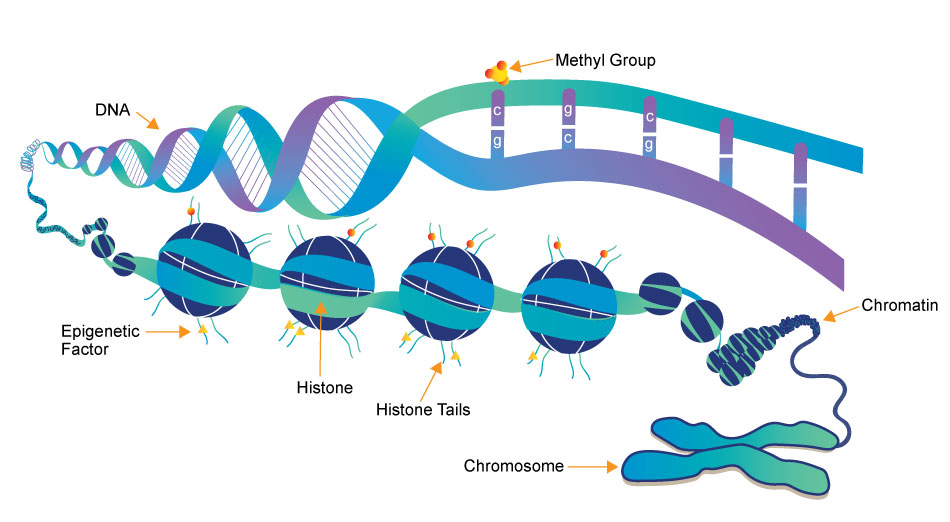Epigenetics


Epigenetics research delves into the molecular mechanisms that control gene expression and cellular traits without altering the underlying DNA sequence. One crucial aspect of this field is the role of small molecules, which act as powerful regulators of epigenetic modifications. These small compounds, typically comprising a few dozen to a few hundred atoms, have emerged as essential tools in understanding and manipulating the epigenome.
- DNA Methylation Inhibitors: Small molecules like 5-azacytidine and 5-aza-2'-deoxycytidine are DNA methyltransferase inhibitors. They block the addition of methyl groups to DNA, leading to DNA demethylation. This can reactivate silenced genes, potentially offering therapeutic avenues for conditions like cancer.
- HDAC inhibitors: HDACs remove acetyl groups from histone proteins, contributing to gene repression. Small molecule HDAC inhibitors, such as Vorinostat and Romidepsin, can reverse this process by increasing histone acetylation, allowing genes to be more accessible for transcription. These inhibitors are being explored for cancer therapy and other conditions.
- Histone Methyltransferase Inhibitors: Small molecules like GSK126 inhibit specific histone methyltransferases, affecting histone methylation patterns. This can alter gene expression, making them promising candidates for cancer and other diseases with epigenetic dysregulation.
- RNA Modulators: Small molecules can also target non-coding RNAs involved in epigenetic regulation. For instance, small molecules called small interfering RNAs (siRNAs) can be designed to target and degrade specific long non-coding RNAs, influencing gene expression.
- Epigenetic Reader Domain Inhibitors: These small molecules target proteins that recognize and bind to specific epigenetic marks. Examples include inhibitors of bromodomain-containing proteins (BET inhibitors), which can disrupt gene regulation by interfering with protein-DNA interactions.
Small molecules in epigenetics research not only provide insights into the fundamental biology of gene regulation but also hold immense promise for developing novel therapeutics. Their ability to selectively modulate specific epigenetic marks and pathways has led to ongoing clinical trials and drug development efforts for various diseases, including cancer, neurological disorders, and inflammatory conditions. Understanding and harnessing the power of these small molecules is at the forefront of modern epigenetics research, offering new hope for precision medicine and targeted therapies.
3 key components involved in the regulation of epigenetic modifications
Epigenetics Writer
Epigenetics writers are enzymes responsible for adding chemical marks or modifications to DNA or histone proteins. These marks include DNA methylation (addition of methyl groups to DNA) and histone modifications (such as acetylation, methylation, phosphorylation, etc.).
Epigenetics Reader
Function: Epigenetics readers are proteins that can recognize and bind to specific epigenetic marks on DNA or histones. These reader proteins interpret the epigenetic code and facilitate downstream cellular processes, such as gene activation or repression.
Epigenetics Eraser
Function: Epigenetics erasers are enzymes responsible for removing or reversing epigenetic marks on DNA or histones. This process allows for the dynamic regulation of gene expression and the resetting of epigenetic states during various stages of development and in response to environmental changes.
-
BET 抑制剂
CPI-0610 羧酸是一种强效的溴结构域和额外末端(BET)蛋白抑制剂。CPI-0610 羧酸在多发性骨髓瘤治疗中具有潜在应用。 -
SMYD3 抑制剂
GSK2807 Trifluoroacetate 是一种高效、选择性的 SMYD3 的 SAM-竞争性抑制剂,具有 14 nM 的 Ki 值和 130 nM 的 IC50 值。 -
PRMT 抑制剂
GSK3368715 dihydrochloride (EPZ019997 dihydrochloride) 是一种口服活性、可逆的、与S-腺苷-L-甲硫氨酸(SAM)非竞争性的 I型蛋白精氨酸甲基转移酶(PRMTs)抑制剂(IC50=3.1 nM (PRMT1), 48 nM (PRMT3), 1148 nM (PRMT4), 5.7 nM (PRMT6), 1.7 nM (PRMT8))。 -
EZH2 抑制剂
Tazemetostat hydrobromide (EPZ-6438 hydrobromide) 是一种强效、选择性且可口服的 EZH2 抑制剂。 -
SHP2 抑制剂
SHP099 hydrochloride 是一种效力强大、选择性高且可口服的 SHP2 抑制剂,其 IC50 为 70 nM。 -
DOT1L 抑制剂
EPZ004777 hydrochloride 是一种效力强大、选择性的 DOT1L 抑制剂,其 IC50 为 0.4 nM。 -
PRMT6 抑制剂
EPZ020411 hydrochloride 是一种强效且选择性的 PRMT6 抑制剂,其 IC50 为 10 nM,对 PRMT6 相比 PRMT1 和 PRMT8 具有超过10倍的选择性。 -
LSD1 抑制剂
GSK-LSD1 dihydrochloride 是一种强效、选择性且不可逆的赖氨酸特异性去甲基化酶1(LSD1)抑制剂,其 IC50 为 16 nM。 -
PAD 抑制剂
Cl-amidine (hydrochloride) 是一种肽基精氨酸脱亚胺酶(PAD)抑制剂,其对PAD4的IC50为5.9 μM。 -
BET/BRD4 bromodomain 抑制剂
AZD5153 6-羟基-2-萘甲酸是 AZD5153 的 6-羟基-2-萘甲酸。AZD5153 是一种强效、选择性且可口服的 BET/BRD4 溴结构域抑制剂;其破坏 BRD4 的 IC50 为 1.7 nM。 -
BET bromodomain 抑制剂
Molibresib besylate(GSK 525762C;I-BET 762 besylate)是一种 BET溴结构域抑制剂,其IC50值为32.5-42.5 nM。 -
PARP1 抑制剂
Niraparib R-enantiomer (MK-4827 R-enantiomer) 是一种优秀的 PARP1 抑制剂,其 IC50 为 2.4 nM。 -
WDR5 and MLL protein-protein interaction 抑制剂
MM-589 TFA 是一种强效的 WD重复结构域5 (WDR5) 和 混合谱系白血病 (MLL) 蛋白-蛋白相互作用抑制剂。 -
WDR5/MLL interaction 抑制剂
MM-102 TFA(HMTase Inhibitor IX TFA)是一种强效的 WDR5/MLL 交互作用抑制剂,在 WDR5 结合实验中实现了 IC50 = 2.4 nM,估计 Ki < 1 nM,其效力是 ARA 肽的200倍以上。 -
HDAC 抑制剂
Sulforaphane 激活 Nrf2 并通过 AMPK 依赖的信号传导抑制高糖诱导的胰腺癌进展。Sulforaphane 已显示出抗癌和抗炎活性。- Satoshi Endo, .et al. , J Biochem, 2021, Mar 17 PMID: 33729485
-
PTP1B 抑制剂
PTP1B-IN-1 是一种强效的蛋白酪氨酸磷酸酶-1B(PTP1B)抑制剂,其半抑制浓度(IC50)为1.6 mM;1,2,5-噻二唑烷-3-酮-1,1-二氧化物框架用于衍生物的合成。 -
SETD8 抑制剂
UNC0379 TFA 是一种选择性的、与底物竞争的赖氨酸甲基转移酶 SETD8 (KMT5A) 抑制剂,其 IC50 为 7.3 μM;相较于其他 15 种甲基转移酶具有选择性。 -
CARM1 抑制剂
SGC2085 hydrochloride 是一种强效且选择性的共激活因子相关精氨酸甲基转移酶1 (CARM1) 抑制剂,其半抑制浓度(IC50)为50纳摩尔。 -
SHP2 allosteric 抑制剂
IACS-13909 是一种选择性、高效、口服活性的 SHP2 配体抑制剂,其 IC50 为 15.7 nM,Kd 为 32 nM。 -
NAD+ competitive 抑制剂 of PARP7
RBN-2397 是一种效力强大、跨物种且可口服的 NAD+ 竞争性抑制剂,针对 PARP7(IC50<3 nM)。 -
peptidylarginine deminase (PAD) 抑制剂
Cl-amidine TFA 是一种口服活性的肽基精氨酸脱亚胺酶(PAD)抑制剂,其 IC50 值分别为 PAD1 的 0.8 μM、PAD3 的 6.2 μM 和 PAD4 的 5.9 μM。 -
EZH2 抑制剂
Gambogenic acid 是藤黄中的活性成分,具有抗癌活性。Gambogenic acid 作为 EZH2 的有效抑制剂,特异性并共价地结合到 EZH2-SET 领域内的 Cys668,并诱导 EZH2 泛素化。 -
HDAC6 抑制剂
Tubastatin A 是一种强效的 HDAC6 抑制剂,其 IC50 值为 15 nM。 -
pan-HDAC 抑制剂
Quisinostat dihydrochloride (JNJ-26481585 dihydrochloride) 是一种口服可用的、强效的全谱 HDAC 抑制剂,其 IC50 分别为 HDAC1 的 0.11 nM、HDAC2 的 0.33 nM、HDAC4 的 0.64 nM、HDAC10 的 0.46 nM 和 HDAC11 的 0.37 nM。Quisinostat dihydrochloride 具有广谱的抗肿瘤活性。 -
Pdia3/ERp57 activator, STAT3 抑制剂
Diosgenin palmitate,也被称为Diosgenin hexadecanoate,是Diosgenin的己十六酸酯。Diosgenin是一种植物甾体皂苷元,是通过酸、强碱或酶对皂苷进行水解后的产物,这些皂苷提取自薯蓣类野生山药的块茎,如Kokoro山药。




